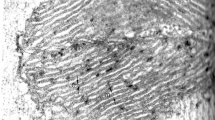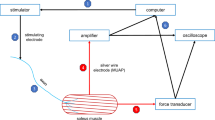Abstract
THE presence of the thyroid gland appears to be necessary for prolonged survival of the cold-acclimatized rat1,2. Rats in the cold also appear to turn over iodine-131 more rapidly than normal3–6, indicating a more rapid than normal accumulation of iodide and release of thyroid hormone. Since oxidative phosphorylation, a process thought by some7–10 to be regulated by the thyroid, has been noted to be partially uncoupled11–13, as well as physically and biochemically more labile in the cold-acclimatized rat12,14, we have investigated the alteration of mitochondrial function following thyroidectomy of cold-exposed and normal rats.
This is a preview of subscription content, access via your institution
Access options
Subscribe to this journal
Receive 51 print issues and online access
$199.00 per year
only $3.90 per issue
Buy this article
- Purchase on Springer Link
- Instant access to full article PDF
Prices may be subject to local taxes which are calculated during checkout
Similar content being viewed by others
References
Leblond, C. P., and Gross, J., Endocrinol., 33, 155 (1943).
Sellers, E. A., You, S. S., and Thomas, N., Amer. J. Physiol., 165, 481 (1951).
Leblond, C. P., Gross, J., Peacock, W., and Evans, R. D., Amer. J. Physiol., 140, 671 (1944).
Cottle, M., and Carlson, L. D., Endocrinol., 59, 1 (1956).
Brown-Grant, K. J., J. Physiol., 131, 52 (1956).
Woods, R., and Carlson, L. D., Endocrinol., 59, 323 (1956).
Martius, C., Proc. Third Intern. Cong. Biochem., Brussels, 1955, edit. by Liebecq, C. (Academic Press, New York, 1956).
Lardy, H. A., and Feldott, G., Ann. N.Y. Acad. Sci., 54, 638 (1951).
Beyer, R. E., Löw, H., and Ernster, L., Acta Chem. Scand., 10, 1039 (1956).
Ernster, L., Ikkos, D., and Luft, R., Nature, 184, 1851 (1959).
Panagos, S., Beyer, R. E., and Masoro, E. J., Biochim. Biophys. Acta, 29, 204 (1958).
Lianides, S. P., and Beyer, R. E., Amer. J. Physiol., 199, 836 (1960).
Smith, R. E., and Fairhurst, A. S., Proc. U.S. Nat. Acad. Sci., 44, 705 (1958).
Panagos, S., and Beyer, R. E., Fed. Proc., 17, 121 (1958).
Schneider, W. C., and Hogeboom, G. H., J. Biol. Chem., 183, 123 (1950).
Lindberg, O., and Ernster, L., Methods of Biochem. Anal., 3, 1 (1956).
Ernster, L., and Löw, H., Exp. Cell Res., Supp., 3, 133 (1955).
Snedecor, G. W., “Statistical Methods”, fourth ed., 31 (Iowa State College Press, Ames, Ia., 1946).
Author information
Authors and Affiliations
Rights and permissions
About this article
Cite this article
LIANIDES, S., BEYER, R. Thyroid Function and Oxidative Phosphorylation in Cold-exposed Rats. Nature 188, 1196–1197 (1960). https://doi.org/10.1038/1881196a0
Issue Date:
DOI: https://doi.org/10.1038/1881196a0
This article is cited by
Comments
By submitting a comment you agree to abide by our Terms and Community Guidelines. If you find something abusive or that does not comply with our terms or guidelines please flag it as inappropriate.



